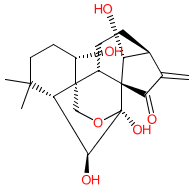GtoPdb is requesting financial support from commercial users. Please see our sustainability page for more information.
|
Synonyms: lasidonin | rubescensin A
Compound class:
Natural product
Comment: Oridonin is a plant-derived terpenoid. It has been identified as an active ingredient in species including Rabdosia rubescens (Chinese sage) [11], Isodon rugosus and Isodon ternifolius. Oridonin is proposed to exhibit a wide range of pharmacological properties, including antineoplastic, anti-angiogenic, pro-apoptotic, anti-asthmatic, anti-inflammatory and anti-bacterial actions [1]. . Rabdosia rubescens root extract has been used in traditional Chinese medicine to treat inflammatory diseases and oral cancer.
The dissection of oridonin's specific mechanism of action and identification of its molecular target(s) is ongoing. In respect of inflammation, oridonin binds covalently to NLRP3 and blocks its interaction with NEK7, which ultimately prevents NLRP3 inflammasone assembly and activation [1]. It does not suppress activation of NLRC4 or AIM2 inflammasomes. Oridonin also inhibits AKT serine/threonine kinases in vitro, which may be associated with its anti-tumour activity [7-8]. Ligand Activity Visualisation ChartsThese are box plot that provide a unique visualisation, summarising all the activity data for a ligand taken from ChEMBL and GtoPdb across multiple targets and species. Click on a plot to see the median, interquartile range, low and high data points. A value of zero indicates that no data are available. A separate chart is created for each target, and where possible the algorithm tries to merge ChEMBL and GtoPdb targets by matching them on name and UniProt accession, for each available species. However, please note that inconsistency in naming of targets may lead to data for the same target being reported across multiple charts. ✖ |
|
|||||||||||||||||||||||||||||||||||
| References |
|
1. He H, Jiang H, Chen Y, Ye J, Wang A, Wang C, Liu Q, Liang G, Deng X, Jiang W et al.. (2018)
Oridonin is a covalent NLRP3 inhibitor with strong anti-inflammasome activity. Nat Commun, 9 (1): 2550. [PMID:29959312] |
|
2. Hua F, Shi L, Zhou P. (2022)
Phenols and terpenoids: natural products as inhibitors of NLRP3 inflammasome in cardiovascular diseases. Inflammopharmacology, 30 (1): 137-147. [PMID:35039992] |
|
3. Jiang J, Zhang N, Song H, Yang Y, Li J, Hu X. (2023)
Oridonin alleviates the inhibitory effect of lipopolysaccharide on the proliferation and osteogenic potential of periodontal ligament stem cells by inhibiting endoplasmic reticulum stress and NF-κB/NLRP3 inflammasome signaling. BMC Oral Health, 23 (1): 137. [PMID:36894905] |
|
4. Jiang K, Feng J, Qi X, Ran L, Xie L. (2022)
Antiviral Activity of Oridonin Against Herpes Simplex Virus Type 1. Drug Des Devel Ther, 16: 4311-4323. [PMID:36573068] |
|
5. Liang L, Wang H, Hu Y, Bian H, Xiao L, Wang G. (2022)
Oridonin relieves depressive-like behaviors by inhibiting neuroinflammation and autophagy impairment in rats subjected to chronic unpredictable mild stress. Phytother Res, 36 (8): 3335-3351. [PMID:35686337] |
|
6. Quinn RJ, Mak T, Littler DR, Rossjohn J, Liu M. (2023)
Discovery of Anti-SARS-CoV-2 Nsp9 Binders from Natural Products by a Native Mass Spectrometry Approach. J Nat Prod, 86 (12): 2630-2637. [PMID:37993134] |
|
7. Song M, Liu X, Liu K, Zhao R, Huang H, Shi Y, Zhang M, Zhou S, Xie H, Chen H et al.. (2018)
Targeting AKT with Oridonin Inhibits Growth of Esophageal Squamous Cell Carcinoma In Vitro and Patient-Derived Xenografts In Vivo. Mol Cancer Ther, 17 (7): 1540-1553. [PMID:29695636] |
|
8. Sun B, Wang G, Liu H, Liu P, Twal WO, Cheung H, Carroll SL, Ethier SP, Mevers EE, Clardy J et al.. (2018)
Oridonin inhibits aberrant AKT activation in breast cancer. Oncotarget, 9 (35): 23878-23889. [PMID:29844859] |
|
9. Wang L, Zhao X, Ding J, Liu Y, Liu H, Zheng L, Zhao H, Sun Z, Li K, Cai J et al.. (2023)
Oridonin attenuates the progression of atherosclerosis by inhibiting NLRP3 and activating Nrf2 in apolipoprotein E-deficient mice. Inflammopharmacology, 31 (4): 1993-2005. [PMID:37155118] |
|
10. Wang W, Ming D. (2024)
Oridonin attenuates apoptosis and NLRP3 inflammasome activation in IL-4-stimulated human bronchial epithelial cells in an in vitro pediatric asthma model. Adv Clin Exp Med, 33 (2): 163-170. [PMID:37486694] |
|
11. Wong AM, Zhang Y, Kesler K, Deng M, Burhenn L, Wang D, Moro A, Li Z, Heber D. (2010)
Genomic and in vivo evidence of synergy of a herbal extract compared to its most active ingredient: Rabdosia rubescens vs. oridonin. Exp Ther Med, 1 (6): 1013-1017. [PMID:22993634] |
|
12. Zhu Y, Wu L, Zhao Y, Wang Z, Lu J, Yu Y, Xiao H, Zhang Y. (2022)
Discovery of oridonin as a novel agonist for BRS-3. Phytomedicine, 100: 154085. [PMID:35405616] |







